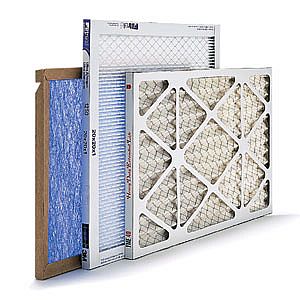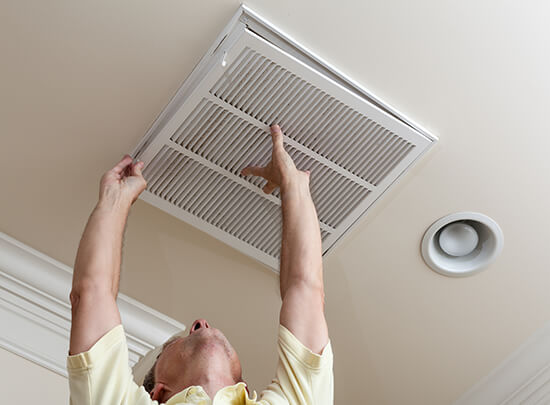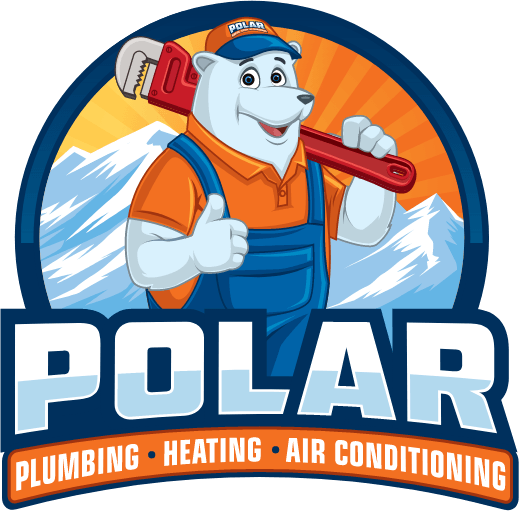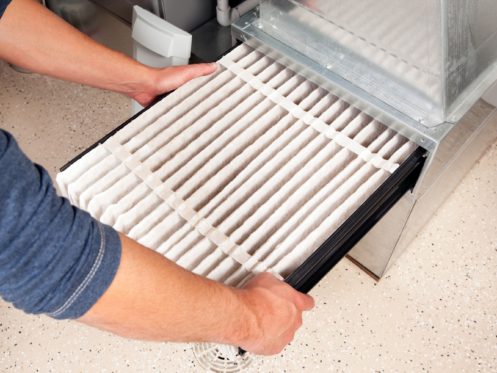You know you should change your furnace filter, and when you go to the store or shop online, the options seem overwhelming. Consider what’s on the market and how to determine which filter is best for your home.
The Furnace Filter’s Jobs
You already know that the filter works to remove various contaminants from the air. The reason this is important is to protect your furnace from those contaminants.
When they enter your system, they clog sensitive areas like the heat exchanger and the blower wheel. As these contaminants collect, the airflow through the system restricts, and your entire system strains. This reduces your furnace’s efficiency and increases the repairs it requires.
In addition to protecting your system’s operation, your air filter helps improve your home’s air quality. The kind of filter you use will determine how much it’ll improve. However, you also have to be careful not to get one that’s too restrictive for your system. Consider the following types of filters and what they’ll do for you.
Disposable Fiberglass Filters
Disposable fiberglass filters are the most common and subsequently are also the cheapest filters on the market. You’ll recognize these as the common flat blue filters that you can easily see light coming through. They are made of strands of spun fiberglass that crisscross throughout the filter.
These filters typically have a MERV 2 or MERV 3 rating and are good for catching the large particles in your air. These particles include pollen, dust mites, dust, and hair.
They also have a very low pressure drop as your furnace runs. The pressure drop refers to how much pressure the air loses as it passes through the filter. The more it drops, the less air eventually comes from your vents, lowering the system’s efficiency.
Disposable Pleated Filters
The next step up is the disposable pleated filter, which is usually made of polyester or cotton paper. These are finer filters than the flat fiberglass options, and they typically have a rating of about MERV 6. The higher rating means it’ll remove smaller particles like mold spores, dust, and lint.
The pleated design increases the surface area of the filtering media. Because of the increased surface area, you get more filtering capability for the same size.
While you have more filtering material, the filter won’t necessarily last longer than the flat fiberglass options. The higher MERV rating means they’ll remove more contaminants from the air and require a replacement more often. These do have a greater pressure drop than your fiberglass filters, so you may notice an increase in energy consumption if you don’t normally use these filters.
High-Efficiency Pleated Filters

High-efficiency filters have a rating of MERV 14 to MERV 16. Due to their thickness and substantial filtering capability, your system must be specially designed to handle these. Not only does the filter have to fit into the housing, but the fan must also create enough draw. Because of this, you normally find these filters in commercial rather than residential applications.
While these filters will remove particles down to bacteria and pet dander, they come with a corresponding cost. It’s common to see the high-efficiency filters run upward of $100, depending on the size you need.
Electrostatic Filters
Electrostatic filters add an entirely new dimension to standard-size filters to help improve their capabilities. These filters have self-charging electrostatic media, which attracts particles floating through the air. Consider how ionizers work, and it’s a very similar idea. The design makes the air charge the filtering media as it flows through.
Electrostatic filters typically have a rating of about MERV 10, which is sufficient for dealing with small particles down to about 1 micron. While this won’t filter out viruses, it does filter out substantially more than your standard options.
These come in both disposable and reusable models. If you opt for the disposable option, be sure to check it monthly so that it doesn’t clog and put strain on your filter.
The reusable options, also called permanent filters, have a machine-washable filtering media. While these do last substantially longer than disposable, you will still need to replace them about every six to eight years. The rating is a little less on the reusable option, typically around MERV 8.
Polyester Filters
Another reusable option is polyester filters. These come in both flat and pleated designs, depending on your preference, and can be obtained in filters up to about 4 inches in depth. The rating on these polyester filters is usually around MERV 8, which means they are effective at removing about 91% of common airborne particles.
HEPA Filters
Anyone who’s concerned with their health and trying to keep common pathogens at bay has at least heard of HEPA filters. These are substantial filters used in some air scrubbers and even in appliances like vacuum cleaners.
With a rating of MERV 16 to MERV 20, the HEPA filter removes particles down to about 0.3 microns. That means these filters remove over 99% of all airborne contaminants.
The downside to these filters is the substantial pressure drop they cause. Often, it is substantial enough to put significant strain on your system and dramatically reduce its heating and cooling efficiency.
If getting the amount of filtering associated with HEPA filters is important, you may want to consider a separate unit. These will allow you to direct the filtering to the specific rooms that need attention without it having to go through your system.
Choosing the Right Filter

Next, look at the size of filter your system requires. There are three dimensions you need to look at, with length and width being first. This is what allows it to sit properly in the housing. Then you have the depth, which must also fit the housing, but may also present too much pressure drop.
Finally, consider how much attention you want to give your filter. Higher-rated filters will need more frequent checking to make sure they get changed on time. If you select a reusable filter, you’ll need to not only wash it but then also let it dry and reinstall it. Disposable filters allow you to simply throw away the old filter, but you have to make sure you have new ones to put in when it’s time to change.
People around Newburgh depend on Polar Plumbing, Heating & Air Conditioning to keep their homes properly heated and cooled. Our expert heating and cooling technicians provide heating tune ups, cooling maintenance, AC repairs, and furnace installation as well as water heater, drain cleaning, and pipe repair services. Call to schedule your heating or cooling service with one of our friendly technicians today.

